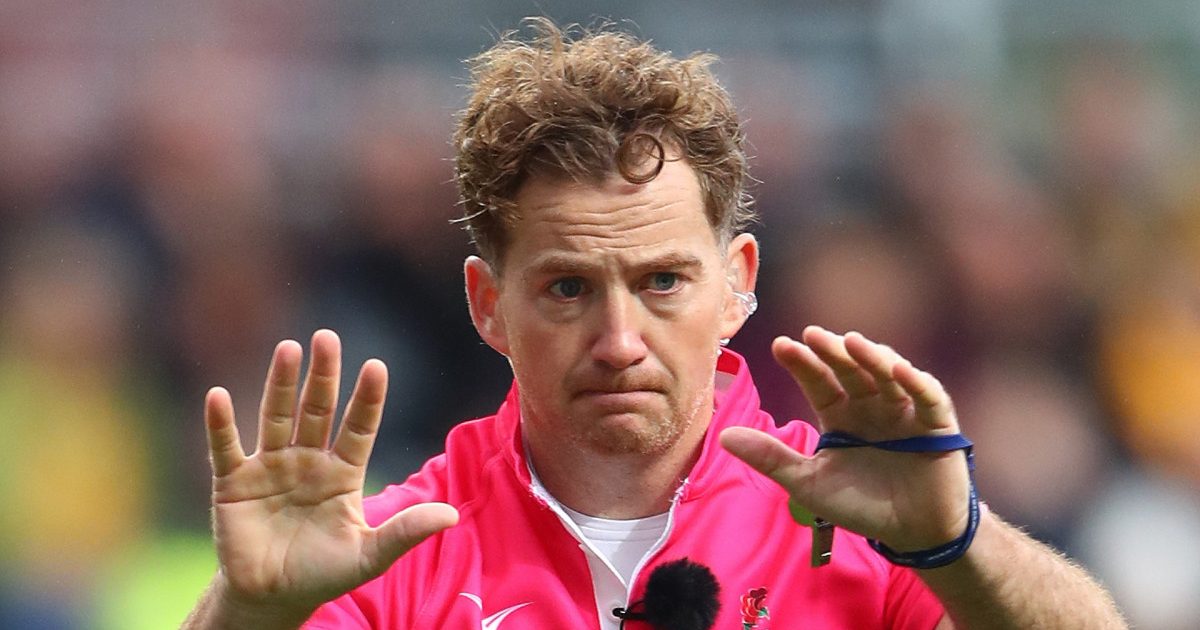Ref Watch: 50:22 and the goal-line drop out explained

With the Northern Hemisphere season now well underway the novelty of 50:22 and the goal-line drop out is already wearing off and at first glance both seem straightforward enough.
Plenty has already been written about the possible impact both will have on tactics – and whether their primary objective of creating space and delivering attacking variety will be achieved.
History tells us that when World Rugby changes law the devil usually lies in the detail. RugbyPass sent Ref Watch columnist Paul Smith to his local referees’ society to find out more about how the law variations will work in practice.
50:22
“The referees’ first impression of 50:22 is that it won’t happen often,” he said.
“But there were a few talking points some of which will inevitably prompt social media debate among fans as they crop up during the first few weeks of the season.
“The key point to remember is that the phase ending with the kick to touch MUST start in the kicking side’s own half.
I really like the 50/22 and with both Burns and Madigan at Ulster, along with the footballing Cooney, they're going to make good use of it. pic.twitter.com/sjzS416Y0V
— The Loose Head (@TheLooseH) September 20, 2021
“Passing it back across halfway from a scrum or lineout for an immediate kick is therefore not a 50:22 option. When this happens, which it inevitably will, the throw-in stays with the receiving team.
“It is also important to understand that a new phase starts after each breakdown, which can be a tackle, ruck or maul.
“A 50:22 can be gained directly from a free kick – this one could catch a few refs out.
“A scrum awarded on halfway, perhaps following a kick-off going directly into touch, is another one to be careful with. This is a 50:22 eligible situation unless the scrum is driven forwards before the ball is released.”
Goal-Line Drop Out
“Wasps boss Lee Blackett described the goal-line drop out as a ‘game changer’ and there are plenty of things for rugby watchers to look out for – and possible pitfalls for officials feeling their way into a new season.
“For a ref, the first question to ask is ‘who put the ball in goal?’ If the defending team carried it over nothing has changed and a five-metre attacking scrum follows.
“But if it is touched down by defenders or becomes unplayable after the attacking side has kicked, carried or knocked it forwards into the in-goal area, play now restarts with a goal-line drop out.
“This means we only have a 22 after the attacking side kicks it dead or following a touch down of a missed drop goal or penalty attempt.”
Is the goal-line drop out taken from under the posts?
No, it can be taken from anywhere across the goal-line.
Where must other players stand?
The receiving players have to retreat to the five-metre line, which doesn’t give the kicker much room especially on a muddy pitch.
The kicker’s teammates must be behind the ball.
The kicker may opt to take the ball deeper into in goal – but in this scenario his teammates must also retreat so they remain behind him when he kicks.
How quickly can it be taken?
Like a 22-metre drop out there is no need to wait for the referee’s whistle or for opponents to realign but the kick does have to go five metres so we are very unlikely to see the quick ‘tap it to myself’ option.
Referees have been advised not to penalise players in front of a quickly-taken goal-line drop out unless they interfere with play and therefore gain an unfair advantage.
What if…
• It doesn’t cross the five-metre line?
The receiving team has the option of playing the ball as it lies, feeding a five-metre centre-field scrum or the kick being retaken.
• It goes into touch without bouncing?
The receiving team has the option of a five-metre centre-field scrum, the kick being retaken, throwing into a lineout on the five-metre line or taking a quick throw in.
• On a windy day it is kicked dead at the other end of the pitch?
The receiving team has the option of a five-metre centre-field scrum or the kick being retaken.
• The kick crosses the five-metre line before blowing back?
Play on
• Receiving players prevent it travelling five metres?
If they cross the five-metre line before the ball is kicked a free kick is awarded
• The kick bounces before the five-metre line then crosses it?
Play on
• The kick bounces into touch beyond the five-metre line?
Play restarts with a lineout
The new date is very close to the Six Nations 🇫🇷https://t.co/CyIJhOwdcK
— RugbyPass (@RugbyPass) September 20, 2021





































































